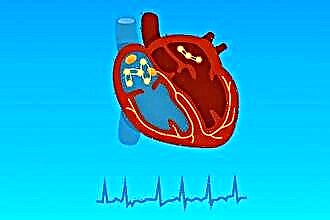Atherosclerosis is a pathological process in which there is a violation of the metabolism of fats in the body. High levels of low-density cholesterol, circulating in the plasma, are deposited on the walls of blood vessels, preventing the free flow of blood. This leads to the development of ischemia of organs and tissues. The brain and myocardium are especially sensitive to a lack of oxygen. This condition ends with a stroke or heart attack, therefore coronary atherosclerosis is a threat to human life.
How the heart is supplied with blood
The heart muscle works constantly and needs a good blood supply. To satisfy her needs, two coronary arteries, originating from the aorta, approach her. The right vessel is responsible for the blood flow to the posterior basal region, septum, and the right ventricle. The rest of the myocardium receives oxygen and nutrition from the left artery, which branches into the anterior interventricular branch (LAD) and the circumflex.
Venous blood is collected through the coronary veins into the sinus, which is located in the right ventricle. If there are plaques in the lumen of the arteries, then the heart experiences an increased demand for oxygen, which increases during exercise. Not getting what it needs, the muscle begins to die off. Angina pectoris, cardiosclerosis and necrosis develop.
Causes and localization of coronary atherosclerosis
Atherosclerosis of the coronary vessels affects the large trunks of the arteries that carry blood to the myocardium, often cholesterol deposits are located near the orifices. They are often found in the LAD, a little less often in the enveloping branch. Plaques are rare in the right coronary artery. Signs of sclerosis are found in the extramural (superficial) parts of the vessels, while in the intramural they remain unaffected. The process is characterized by diffuse lesions with varying degrees of narrowing.

The reasons for the development of pathology are an increase in cholesterol levels and metabolic disturbances in obesity, malnutrition, and low physical activity. At risk are people with a hereditary predisposition and addiction to smoking. This deviation is often noted in men after 45 and in women over 55 years old.
Atherosclerosis does not develop as a local pathology, usually all vessels are affected. Lack of treatment ends with a heart attack, stroke, the development of heart and brain failure, disability and death of the patient.
Symptoms
Atherosclerosis of the coronary arteries of the heart usually does not appear at the initial stage and can be detected accidentally during diagnostic studies. This is due to the fact that the lumen of the vessels is not yet sufficiently filled, and the blood flow is practically not disturbed. Slightly slowing it down can cause shortness of breath, chest discomfort during stress or physical overload, fatigue and weakness.
When the process aggravates, the patient has the following complaints:
- burning, pressure and pain in the region of the heart;
- feeling out of order;
- lack of air.
The progression of atherosclerosis and a significant decrease in blood flow is manifested in the form of angina attacks. When a plaque breaks off, it can get from a large vessel into a smaller one and block the flow of oxygen in a certain area of the myocardium. This leads to the development of a heart attack.
Diagnostics
To prevent acute conditions in the late stages of the disease, you must immediately consult a doctor and diagnose atherosclerosis. Its purpose is:
- confirmation or refutation of damage to the vascular wall;
- clarification of the localization and extent of the spread of the process;
- assessment of the functional state of ischemic tissues.
Laboratory methods
With the help of laboratory tests, you can:
- determine the progression of pathology;
- evaluate the effectiveness of treatment.
For this, the levels of cholesterol, lipids and triglycerides in the blood are measured. The complete and detailed picture that can be obtained regarding the content of these substances in the plasma is called a lipid profile. Particular attention should be paid to low-density cholesterol (LDL). It is his concentration that is considered atherogenic. The increase in triglycerides is also a health threat. Elevated high-density lipoprotein (HDL) levels indicate a low risk of plaque formation in the vascular intima.
For the diagnosis of atherosclerosis, the determination of the atherogenic coefficient is of great importance. It is calculated simply. The resulting HDL number is subtracted from the total amount of cholesterol and divided by the LDL. The normal indicator is in the range from 3 to 5, and exceeding the value indicates the danger of developing atherosclerosis.
Instrumental
Angiography is the gold standard for diagnosing myocardial ischemia. This far from new method allows me and my colleagues to clearly define the cause of pain in the heart during an attack or rhythm disturbance. The introduction of a contrast agent and observation of its distribution in the coronary vessels allows you to accurately identify the site of occlusion. This type of research helps to establish an accurate diagnosis and determine the method of treatment. Its disadvantage is its high invasiveness and the need for careful preparation.
Computed tomography using a contrast agent allows you to obtain a three-dimensional image of the affected vessel and assess the state of the heart that is undergoing changes. MRI makes it possible to consider the pathology in volumetric form and in high quality, while the use of additional drug administration is not required. But this test cannot be done if there is a pacemaker or other metallic impurities in the body.
Features of stenosing coronary sclerosis
When using various techniques, it is possible to determine atherosclerosis of the coronary artery with stenosis by the following signs:
- a pronounced decrease in the speed of blood flow in the affected area;
- the presence of a plaque overlapping the lumen by 50% or more of the norm;
- changes in the myocardium in the area of the narrowed coronary artery.
Treatment
The most important point in the treatment of atherosclerosis of the heart vessels is the normalization of lipid metabolism. For this purpose, apply:
- A diet with restriction or complete elimination of animal fats and foods high in cholesterol.
- Drugs for inhibiting, absorbing, cleaving LDL.
- Operations to restore optimal blood flow in the coronary arteries.
What medications to take
At the moment, I can recommend several types of medicines that will help slow down the progression of the disease:
- The most effective drugs are statins. They allow you to quickly lower cholesterol levels and, with constant use, keep it within the acceptable range. The strongest is considered Rosuvostatin, which is prescribed in case of ineffectiveness of drugs of other generations. The most studied is Atorvastatin, it is recommended for life-long use and helps prevent the development of heart attacks.
- Fibrates. They help to normalize fat metabolism, remove excess lipids with bile. They are taken mainly in diabetes mellitus. In combination with statins, they are prescribed extremely rarely, only in the case of familial hyperlipidemia. Representatives of this group: Regulip, Bezafibrat.
- A nicotinic acid. Most often it is used in injectable form, but it is also available in tablets (Niceritol, Enduracin).The tool helps to expand the lumen of blood vessels and relieve spasms. It is used in courses of two weeks three times a year.
- The new drug Ezetimibe lowers the level of lipids by inhibiting their absorption in the intestine, unlike the above drugs, it does not affect the excretion of bile and does not block the synthesis of cholesterol in the liver cells. In a particularly severe form of atherosclerosis, it can be recommended for use together with statins.
- Omega-3 unsaturated fatty acids. Helps stabilize cholesterol plaques, slows down the rate of their growth. Contained in preparations Fish oil, Vitrum Cardio Omega 3, Omeganol Forte. Well tolerated and combined with other drugs.
Surgical techniques
When stenosing atherosclerosis of the coronary arteries progresses, the only way to save the patient's life is to perform an operation. The aim of the intervention is to restore blood flow to the affected area. For this, the following are carried out:
- Bypass grafting and prosthetics of coronary vessels. It is not used for severe advanced heart failure and other pathologies in the terminal stage. A long recovery period is expected.
- Stenting and angioplasty. It can be used with moderate narrowing of the vessel lumen, not used in case of complete blockage.
Surgical treatment can significantly improve the patient's condition. In many patients, working capacity is restored, myocardial tolerance to physical activity increases, and angina attacks stop.
Doctor's advice: how to improve the condition
I would like to advise patients with atherosclerosis, in order to prevent its progression and improve the quality of life, to adhere to the following rules:
- Compliance with a diet. If you are overweight, the total daily calorie intake should not exceed 2200 kcal. In this case, the BZHU is calculated as follows: 100/30/70 g. The number of products with cholesterol is no more than 30 g / day. Without obesity, you can consume 2,700 kcal, while proteins - 100 g, carbohydrates - up to 400 g, fats - up to 80 g. Half of the recommended lipids should be of plant origin.
- Dosed walking in the presence of signs of coronary artery disease. To do this, you should choose a special route (terrenkur). The starting distance should be 500 m, you can take a short break every 5 minutes. In 60 seconds, you need to walk 60-70 steps. It is necessary to increase the load by 200 m per day - up to one kilometer.
- At the initial stage of atherosclerosis, it is necessary to walk 5 km a day, gradually increasing the distance to 10 km at a speed of 5 km / h. Acceleration should be done from time to time. After free passage of the entire distance, you can start running and alternate it with walking.
With regular exercise and adherence to a diet, the prognosis for the duration and improvement of the quality of life becomes more favorable. This is confirmed by numerous international studies.



